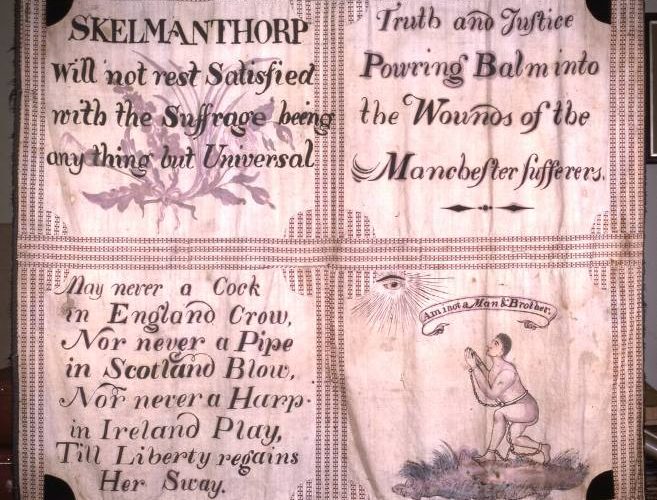Skelmanthorpe Flag
Theme: Social and cultural revolution, Challenging law and order: British riots and reforms, The impact of industry, Challenging slavery: abolition and opposition
The 1800s saw a series of protests and uprisings in Britain, as people campaigned against slavery, unjust taxes and laws imposed by the government and in support of fair wages, the right to vote and to have their voices heard in parliament. Protest flags, posters and banners carrying radical slogans were a popular way for campaigners to get their message across at marches and rallies, and to cooperate without endangering individuals. The Skelmanthorpe flag was created in secret, in Huddersfield, initially to honour the victims of what became known as the Peterloo Massacre, in 1819.
The Skelmanthorpe flag is, in fact, a banner which was hung from a frame so that its simple text, symbols and images could be seen from a distance and understood by both literate and illiterate people. It is made of cotton and measures about one-and-a-half metres across. Although created to commemorate the victims of the Peterloo Massacre, it also represents major causes of the time.
Clockwise, from the top left:
• The first panel shows support for the Chartists, demanding ‘universal suffrage’ – that all ordinary men be allowed to vote and stand for parliament. (Ironically, the movement didn’t include women).
• Next, that the victims of the Peterloo Massacre should receive justice for the violence inflicted at a peaceful protest in St Peter’s Fields, Manchester in 1819.
• Then, a version of the famous anti-slavery image and slogan – Am I not a man and a brother? – designed by Josiah Wedgewood for the Society for the Abolition of the Slave Trade. Above is the all-seeing eye of God, used as a symbol of justice.
• Finally, the piece of verse is a rallying cry for justice and liberty for all – perhaps a reference to the enduring slogan of the recent French Revolution: Liberte, Fraternite, Egalite, calling for equality and freedom in France.
The banner was paraded at mass meetings and demonstrations throughout the area, beginning in Almondbury Bank in November 1819 and later carried to major Chartist rallies including the one at Peep Green (near Hartshead) in 1837, attended by around 250,000 people. The authorities reacted harshly to these protests and the banner had to be hidden in a box and probably buried, between outings, to keep it safe from government agents who would have had it destroyed and its keepers prosecuted. It was later discovered folded in a disused warehouse in the region.
Did you know..?
Jody Whittaker, the first female actress to play Dr Who (a revolution in the world of science fiction) is from Skelmanthorpe.
Use our Classroom resources to investigate this object and the theme of Protest further.
Highlights:
- Using objects, artworks and other sources to find out about the past
- Peterloo graphic novel and activities
- Peterloo graphic novel (redacted version)
- Enquiry: Why did workers protest in the Age of Revolution?
- How to make an interactive Revolutionary banner
- Twitter campaigns
And much more…
Sources & acknowledgements
This object description and its related educational resources were researched and written by our team of historians and education specialists. For further information see the item’s home museum, gallery or archive, listed above.
- Related resources
-
Education overview
You can access a range of teachers resources related to this object and more on our education page.
Please also see our glossary of terms for more detailed explanations of the terms used.
-
Curatorial info
- Originating Museum: Tolson Museum
- Production Date: 1819
- Creator: Mr Bird
- Creation Place: Skelmanthorpe
- Original record
-
Use this image
- Rights Holder: © Kirklees Museums and Galleries
- License Type: All Rights Reserved



